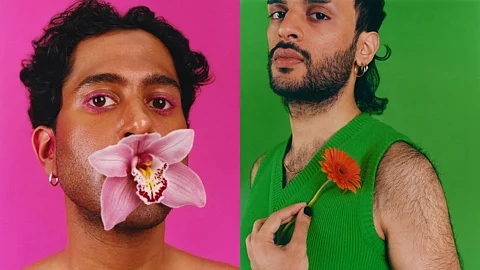
- HOMEGROWN WORLD
- #HGCREATORS
- #HGEXPLORE
- #HGVOICES
- #HGSHOP
- CAREERS
- ABOUT US
- CONTACT US

Photographer Alia Romagnoli moved to the UK to study cinema, thinking she’d one day return to work in Bollywood. But somewhere in between, she found herself gravitating towards photography and she hasn't looked back since. What started as an instinctive shift soon became her way of storytelling, worldbuilding, and, crucially, of coming home to herself.
Today, Alia is best known for her sumptuous, high-saturation portraits that blur the line between personal memory and shared cultural archives. Based in London but deeply rooted in South Asian visual traditions, her photography is a celebration of identity — often centring queer and diasporic communities.
Her images are both aesthetically rich and emotionally abundant, marked by maximalist colour palettes, theatrical sets, and a warmth that feels at once fantastical and deeply familiar. Her visual style is a heady confluence of hand-painted backdrops, intricate textiles, soft yet bold lighting, and joyful embellishments.
“Collaboration is such a big part of the themes I explore,” she explains. “Especially on personal projects, I want the photographs to feel honest and for the people I work with to feel like they are being depicted in their truest form.” Often guided by themes like queer tenderness, family relationships, or individual expressions of selfhood, Alia cultivates an environment where visual tools like colours, props and the set colour and set become collaborators too. Her process is open-ended but thoughtful — she often shares references and mood boards with collaborators and just as frequently builds a shoot around their suggestions, allowing for a porous, co-creative experience. “Sometimes it’s very thought through, considered, and each decision carries meaning. Other times, it’s random, spontaneous and we are just enjoying the process of making a joyful photograph — both ways of working are special to me.”
This sense of emotional attunement can be traced back to her earliest visual memories, grounded in the textures, and vignettes of her childhood in Bangalore. One of her most cherished belongings was a point-and-shoot film camera her Ajji (grandmother) bought her from the local bazaar —preloaded with 36 frames of Kodak Colour Plus. “The prints that came back were my prized possessions — it was a documentation of my family, friends, the everyday life around me growing up in Bangalore and the colour, chaos and beauty of my world.”
Those early encounters — whether helping her mother choose hand-embroidered outfits for family functions or playing mythic roles from Amar Chitra Katha comics, left a strong imprint on her visual vocabulary: “I have always loved details, and store these visual images to then go back to when I’m in need of inspiration or am feeling nostalgic.” This nostalgia was sharpened when she moved to the UK. “There are considerably less displays of colour here and I wanted my work to be saturated with it,” she shares. “I wanted to create images that both reminded me of my view of the world as a child but also reflect my identity now and the communities I have found home in.”
Alia's work draws from a kaleidoscope of visual references: Hassan Hajjaj’s exuberant cultural bricolage, Tim Walker’s fantasy-laden sets, Wes Anderson’s pastel geometries, and technicolour melodramas of the 1950s among others. “Old Bollywood always, but also coming-of-age romcoms and girly superhero cartoons like the Winx Club,” she notes. “I’m unapologetically kitsch!”
At the same time, her visual practice is deeply intentional in how it honours and reinterprets South Asian archives. 'Bhavacitra', for instance, emerged during the pandemic when she returned to Bangalore and began engaging with lost family photography traditions. Inspired by the STARS archive in Pondicherry, she focused on hand-painted backdrops — a dying practice once popular in regional cinema and Bollywood billboards — recasting them within contemporary portraiture. “I wanted to honour the lost art form, but create a tangible memory for my own community and local area in Bangalore when things eased up during the pandemic.”
In another series, centred on mothers and daughters, she delved into intergenerational matriarchal relationships using Mughal miniature aesthetics, collaborating with South Asian artist Heleena, who reinterprets the art form. These projects reflect Alia's ability to straddle the line between documentation and fictional imaginations. In the generous theatricality of Alia Romagnoli's images, we see not only the influence of cultural impressions, but also the active construction of a shared iconography, one that is inscribing new narratives into the visual memory of South Asian identity.
Follow Alia here.
If you enjoyed reading this here's more from Homegrown:
Photographs As Relics Of Feelings: The Ethereal Image-Making Practice Of Vijay Sarathy
What Makes You Stay?: The Layered Storytelling In Tanmay Saxena's Photography
Photography, Drawing, & The Art Of Memory: Inside The Visual World Of Sawani Chaudhary
